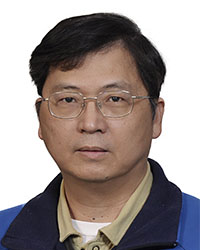周錫增 Hsi-Tseng Chou
Distinguished Professor, Graduate Institute of Communication Engineering, National Taiwan University
主要研究領域:
高增益天線技術、電磁理論、電磁波傳播、高頻數值電磁技術、無線通訊系統、雷達系統Major Research Areas:
High-Gain/Smart Antenna Technologies, Advanced Electromagnetic Theories, Propagation of Electromagnetic Waves, High-Frequency EM Numerical Techniques、Radar System研究領域摘要:
Research Summary:
In the history of Prof. Chou’s research activities, significant efforts have been made to realize high-gain, intelligent antennas and the required technologies, including fundamental electromagnetic (EM) theories, antenna components, passive RF components, numerical electromagnetic techniques, and optimization algorithms. The objective considers the application potential as the core to developing antenna- and RF-system-related technologies and enabling industrial applications to build RF systems. Current efforts focus on reflector antennas, active phased array antennas, reflectarray antennas, and transmit array antennas with significant works to drive its potential and advanced applications. The primary activities in recent years focused on the following subjects:
(1) The required advanced techniques to realize the vast antennas include fast analysis/numerical EM techniques, antenna design/realization algorithms, scope extension of application scenarios, and the cloud-based optimization of antenna networking and intelligent operations.
(2) The buildup of electromagnetic foundations for the high-gain antennas, which includes time- and frequency-domains EM theories. The goal is to build the foundation based on the Uniform Geometrical Theory of Diffraction (UTD) architecture to provide the diffraction mechanisms that allow one to design the antennas by considering the local diffraction phenomena.
(3) The technologies of high-gain antennas for the next generations of mobile communications, satellite communications, and unique applications. Significant efforts are being made to develop technologies for the intelligent operation of high-gain antennas to fulfill the needs of dynamic applications. The development trends utilize millimeter wave frequency bands and their technologies.
(4) The measurement, signal decomposition, and multipath suppression/decomposition techniques to characterize the extensive antenna systems. The objective is to overcome the limitations of measurement systems in a limited space. The final goal attempts to integrate the measurement system into the numerical software so that the overall characterization of antenna systems simulating the application scenarios can be performed to provide the reference in the design stages.
(5) Antenna system, Massive MIMO system, innovative antenna system for 5G/B5G/6G applications of next-generation mobile communications (at sub-6 GHz, millimeter wave frequencies, and Sub-THz). Modularization technology to integrate antenna and RF IC to form an antenna system in package (Antenna-in-Package, AiP, and Antenna-in-Module, AiM). Active antenna array systems are the final destination of the studies.
(6) Tracking antenna system and radar system for the applications of LEO satellites, UAVs, and vehicles in communications and target detection.

-
B.S.
National Taiwan University, 1988 -
M.S.
The Ohio State University, 1993 -
Ph.D.
The Ohio State University, 1996
-
Address
EE2-441,
Department of Electrical Engineering,
National Taiwan University,
Taipei 106, Taiwan -
Phone
+886-2-33669646 -
FAX
+886-2-2367-1909 -
Email:

-
Office Hour
Mon 09:00~10:00, Wed. 15:00~16:00 (or by appointment)